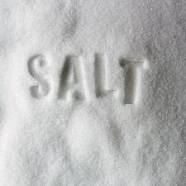{googleAds}
<div style="float:left">
<SCRIPT SRC="http://g.admedia.com/banner.php?type=graphical&pid=2036944&size=300x250&page_url=[ENCODED_PAGE_URL]" TYPE="text/javascript" ></SCRIPT>
<br>
<!-- BEGIN JS TAG - mediabharti_RevShare_Banner_300X250 < - DO NOT MODIFY -->
<SCRIPT SRC="http://ads.ozonemedia.com/ttj?id=1230088&cb=[CACHEBUSTER]&pubclick=[INSERT_CLICK_TAG]" TYPE="text/javascript"></SCRIPT>
<!-- END TAG -->
</div>
{/googleAds} Recently several government, public health, and professional organizations have made it their objective to implement strategies to reduce sodium intake. Yet consumers are apprehensive about buying products with low sodium claims because they perceive low-, no-, and reduced-sodium claims as a sacrifice to flavor. Therefore companies are finding less drastic ways to reduce sodium in foods without concerning consumers such as leaving off labeling claims on packages and rebranding the whole product to emphasize low sodium.
The first step to reducing salt in food products begins with maximizing how salt in the product interacts with the tongue. Different crystal sizes and shapes can be used as found in varieties of kosher salts, sea salts and specialty salts to increase the boldness of salt’s flavor. For example, increasing salt’s surface area reach and reducing its general density is a solution for items like chips, crackers, and baked goods. One study by Spanish researchers using the National Health and Nutrition Examination Survey (NHANES) 2007–2010 data demonstrated that potential use of newly developed hollow salt microspheres on commonly eaten foods could reduce sodium intake by approximately 9 percent.
Several companies are also developing products with potassium chloride in combination with salt in order to reduce sodium in foods while masking the metallic taste that can sometimes go along with potassium chloride. Applications include salad dressing, mayonnaise, processed meat and poultry products, cheese and dairy products, baked goods and snacks, as well as prepared meals and entrees in restaurant chains. The next step when reducing sodium and finding substitutes is to work on savory notes to enhance salt’s flavor using glutamate-containing ingredients such as glutamate-rich yeast and mushroom extracts.
<div style="float:left">
<SCRIPT SRC="http://g.admedia.com/banner.php?type=graphical&pid=2036944&size=300x250&page_url=[ENCODED_PAGE_URL]" TYPE="text/javascript" ></SCRIPT>
<br>
<!-- BEGIN JS TAG - mediabharti_RevShare_Banner_300X250 < - DO NOT MODIFY -->
<SCRIPT SRC="http://ads.ozonemedia.com/ttj?id=1230088&cb=[CACHEBUSTER]&pubclick=[INSERT_CLICK_TAG]" TYPE="text/javascript"></SCRIPT>
<!-- END TAG -->
</div>
{/googleAds} Recently several government, public health, and professional organizations have made it their objective to implement strategies to reduce sodium intake. Yet consumers are apprehensive about buying products with low sodium claims because they perceive low-, no-, and reduced-sodium claims as a sacrifice to flavor. Therefore companies are finding less drastic ways to reduce sodium in foods without concerning consumers such as leaving off labeling claims on packages and rebranding the whole product to emphasize low sodium.
The first step to reducing salt in food products begins with maximizing how salt in the product interacts with the tongue. Different crystal sizes and shapes can be used as found in varieties of kosher salts, sea salts and specialty salts to increase the boldness of salt’s flavor. For example, increasing salt’s surface area reach and reducing its general density is a solution for items like chips, crackers, and baked goods. One study by Spanish researchers using the National Health and Nutrition Examination Survey (NHANES) 2007–2010 data demonstrated that potential use of newly developed hollow salt microspheres on commonly eaten foods could reduce sodium intake by approximately 9 percent.
Several companies are also developing products with potassium chloride in combination with salt in order to reduce sodium in foods while masking the metallic taste that can sometimes go along with potassium chloride. Applications include salad dressing, mayonnaise, processed meat and poultry products, cheese and dairy products, baked goods and snacks, as well as prepared meals and entrees in restaurant chains. The next step when reducing sodium and finding substitutes is to work on savory notes to enhance salt’s flavor using glutamate-containing ingredients such as glutamate-rich yeast and mushroom extracts.










Related Items
Indusfood 2025: A global showcase of Indian Food Economy
Green views lead to healthier food choices, says study
World Food India 2023 drives many collaborations and investments